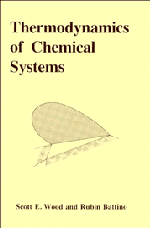Book contents
- Frontmatter
- Contents
- Preface
- Notation
- 1 Introduction
- 2 Temperature, heat, work, energy, and enthalpy
- 3 The second law of thermodynamics: the entropy function
- 4 Gibbs and Helmholtz energy functions and open systems
- 5 Conditions of equilibrium and stability: the phase rule
- 6 Partial molar quantities
- 7 Ideal gases and real gases
- 8 Liquids and solids: reference and standard states
- 9 Thermochemistry
- 10 Phase equilibrium
- 11 Chemical equilibrium
- 12 Equilibria in electrochemical systems
- 13 Surface effects
- 14 Equilibrium conditions in the presence of an external field
- 15 The third law of thermodynamics
- Appendices
- Cited references and selected bibliography
- Subject index
3 - The second law of thermodynamics: the entropy function
Published online by Cambridge University Press: 28 October 2009
- Frontmatter
- Contents
- Preface
- Notation
- 1 Introduction
- 2 Temperature, heat, work, energy, and enthalpy
- 3 The second law of thermodynamics: the entropy function
- 4 Gibbs and Helmholtz energy functions and open systems
- 5 Conditions of equilibrium and stability: the phase rule
- 6 Partial molar quantities
- 7 Ideal gases and real gases
- 8 Liquids and solids: reference and standard states
- 9 Thermochemistry
- 10 Phase equilibrium
- 11 Chemical equilibrium
- 12 Equilibria in electrochemical systems
- 13 Surface effects
- 14 Equilibrium conditions in the presence of an external field
- 15 The third law of thermodynamics
- Appendices
- Cited references and selected bibliography
- Subject index
Summary
In the development of the second law and the definition of the entropy function, we use the phenomenological approach as we did for the first law. First, the concept of reversible and irreversible processes is developed. The Carnot cycle is used as an example of a reversible heat engine, and the results obtained from the study of the Carnot cycle are generalized and shown to be the same for all reversible heat engines. The relations obtained permit the definition of a thermodynamic temperature scale. Finally, the entropy function is defined and its properties are discussed.
Heat and work reservoirs
We define a heat reservoir as any body, used as part of the surroundings of a particular system, whose only interaction with the system is across a diathermic boundary. A heat reservoir is then used to transfer heat to or from a thermodynamic system and to measure these quantities of heat. It may consist of one or more substances in one or more states of aggregation. In most cases a heat reservoir must be of such a nature that the addition of any finite amount of heat to the system or the removal of any finite amount of heat from the system causes only an infinitesimal change in the temperature of the reservoir.
A work reservoir is similarly defined as any body or combination of bodies, used as part of the surroundings, whose only interaction with the system is one that may be described in terms of work.
- Type
- Chapter
- Information
- Thermodynamics of Chemical Systems , pp. 24 - 46Publisher: Cambridge University PressPrint publication year: 1990



